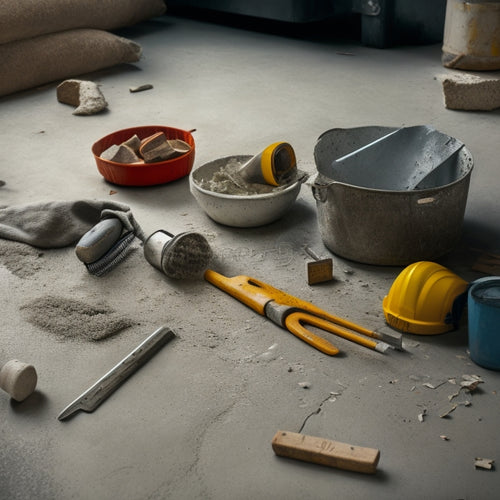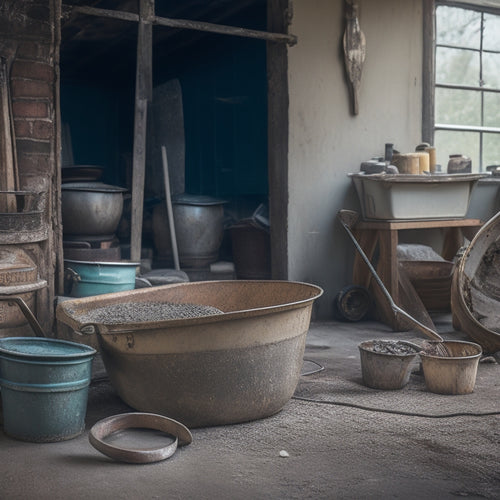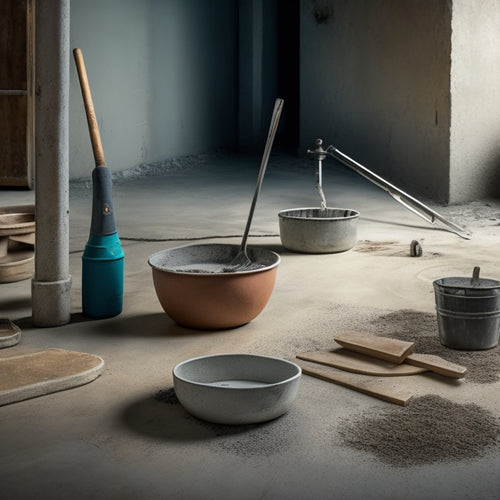
5 Best Tools for Concrete Block Construction
Share
When building with concrete blocks, you'll need a reliable trowel for spreading and leveling mortar, a spirit level and straightedge for a level foundation, and a string line and line pins for straight courses. Safety gear, including hard hats and gloves, is also vital. For mixing and pouring concrete, a mixer, wheelbarrow, and shovel are must-haves. A block saw and shaping jigs will help you cut and shape blocks accurately. Laser levels and alignment rods guarantee precise leveling and alignment. Finally, a jointer or specialized trowel is necessary for filling and smoothing joints. With these tools, you'll be well on your way to a solid, durable structure, and exploring these tools in more detail will reveal the key to a professional-looking finish.
Key Takeaways
- A quality trowel is essential for spreading and leveling mortar between blocks, ensuring a strong and even foundation.
- A reliable mixer and wheelbarrow or mixing tub are necessary for mixing and transporting concrete efficiently.
- A block saw is a crucial tool for making quick and accurate cuts through concrete blocks, enabling precise fitting and shaping.
- A laser level and alignment rods are vital for achieving precise leveling and alignment, ensuring a solid foundation and structural integrity.
- A jointer or specialized trowel is necessary for filling and smoothing joints between blocks, creating a strong and watertight seal.
Essential Block Laying Equipment
As you begin constructing with concrete blocks, having the right equipment is crucial to guarantee a sturdy and level foundation. You'll need a variety of tools to ascertain efficient and accurate block laying techniques.
First, invest in a quality trowel, which is used to spread and level mortar between blocks. A spirit level and a straightedge will help you achieve a level and plumb foundation. A string line and line pins will guide your block placement, guaranteeing a straight and even course.
Don't forget essential safety gear, including hard hats, safety glasses, and gloves to protect yourself from falling blocks and sharp edges. Steel-toed boots and a dust mask are also must-haves for a safe working environment.
Additionally, a mix of hand tools, such as a jointer, a pointing trowel, and a hammer, will aid in the block laying process. A mortar hawk and a bucket will facilitate the mixing and transporting of mortar.
With these essential tools, you'll be well-equipped to excel in block laying techniques and construct a solid foundation.
Concrete Mixing and Pouring Tools
With your block laying equipment in place, you're ready to focus on preparing the concrete that will hold your structure together.
Concrete mixing and pouring tools are vital for achieving a strong, durable bond between concrete blocks. You'll need a reliable mixer to combine cement, aggregate, and water according to the manufacturer's instructions. A wheelbarrow or mixing tub will help you transport and mix the concrete, while a shovel and trowel will aid in mixing and pouring.
When it comes to mixing techniques, it's important to follow a consistent pattern to avoid air pockets and uneven distribution of materials. Start by adding dry ingredients to the mixer, followed by water, and mix until the desired consistency is reached.
Use a pouring method that minimizes segregation, such as pouring in a circular motion or using a chute to direct the flow. A level and screed will help you achieve a smooth, even surface.
Block Cutting and Shaping Tools
Precision is key when it comes to cutting and shaping concrete blocks to fit your structure's unique design. You'll need the right tools to make accurate cuts and shapes, guaranteeing a strong and stable structure.
Block saws are a must-have for any concrete block construction project. These powerful saws are designed to cut through concrete blocks quickly and efficiently, allowing you to make precise cuts with minimal effort.
When it comes to shaping concrete blocks, shaping jigs are essential. These jigs help you create complex shapes and angles, guaranteeing a perfect fit for your structure's design. By using a shaping jig, you can achieve precise angles and curves, making it easier to assemble your structure.
Remember to always follow safety guidelines when operating these tools, and take necessary precautions to avoid accidents.
With the right block cutting and shaping tools, you'll be able to achieve professional-looking results and guarantee the integrity of your structure.
Leveling and Alignment Essentials
How level is your concrete block structure? Achieving accurate leveling and alignment is vital in concrete block construction to guarantee a solid foundation, prevent structural issues, and facilitate efficient building processes.
To secure precise leveling, you'll need reliable tools. Laser levels are a must-have for any concrete block construction project. These devices project a level line or dot onto the surface, allowing you to accurately check and adjust the level of your blocks.
Additionally, alignment rods are indispensable for maintaining consistent block alignment throughout the structure. These rods provide a visual reference point, enabling you to verify that each block is properly aligned with the previous one.
Finishing and Jointing Accessories
As you move on from laying the foundation, you'll need to focus on finishing and jointing your concrete block structure. This vital step requires the right tools and materials to achieve a professional finish.
For joint finishing techniques, you'll need a jointer or a specialized trowel to fill and smooth out the joints between blocks. Additionally, joint sealing materials such as sealants, backer rods, and foam tapes will help guarantee a watertight seal and prevent water infiltration.
When selecting joint sealing materials, consider factors like durability, adhesion, and flexibility. Look for materials that can withstand environmental conditions and last the lifespan of your structure. For instance, silicone sealants are ideal for high-traffic areas, while polyurethane sealants work well for joints subject to movement.
To guarantee a consistent finish, use a joint finishing tool with adjustable depth control to achieve the desired joint width.
Don't forget to clean the joints thoroughly before applying sealants to guarantee a strong bond. By using the right finishing and jointing accessories, you'll achieve a strong, durable, and visually appealing concrete block structure.
Frequently Asked Questions
What Is the Recommended Temperature for Laying Concrete Blocks?
When laying concrete blocks, you'll want to guarantee the temperature is between 40°F and 90°F (4°C and 32°C) to minimize temperature effects and promote ideal block curing, as extreme temperatures can compromise the structure's integrity.
Can I Use a Hammer Drill for Mixing Concrete?
You can't use a hammer drill for mixing concrete, as it's designed for drilling and hammering, not mixing; instead, opt for a dedicated concrete mixer or a drill with a mixing paddle attachment, employing techniques like slow-speed mixing and scraping the sides.
How Often Should I Clean My Concrete Block Laying Tools?
You should clean your tools after every use to prevent concrete residue buildup, and establish a weekly cleaning schedule for more thorough maintenance, ensuring ideal tool performance and extending their lifespan through proper tool maintenance.
What Safety Gear Is Necessary for Block Construction Sites?
You're as prepared as a soldier heading into battle when you don your necessary safety gear on a block construction site, where hazards lurk around every corner; invest in essential safety equipment, like hard hats, gloves, and goggles, to protect yourself from site hazards.
Can I Reuse Concrete Block Molds After Initial Use?
You can reuse concrete block molds after initial use, but proper mold maintenance is essential to extend mold longevity; clean and lubricate molds regularly to prevent damage and guarantee consistent block quality in future casts.
Conclusion
You've got the basics of concrete block construction down, and now you're equipped with the top tools to get the job done efficiently. According to the National Ready Mixed Concrete Association, the average American uses about 6.4 tons of concrete in their lifetime - a staggering statistic that highlights the importance of quality construction. With these essential tools, you'll be well on your way to building structures that stand the test of time.
Related Posts
-

Top 10 Concrete Repair Tools for Small Fixes
You'll need the right tools to tackle small concrete repairs efficiently and effectively. When it comes to small fixe...
-

Top Tools for Mixing Concrete at Home
When mixing concrete at home, you'll need a range of tools to guarantee a successful operation. Start with essential ...
-

Why You Need These Concrete Overlay Tools
When tackling a concrete overlay project, you need the right tools to achieve a flawless finish and avoid costly mist...


